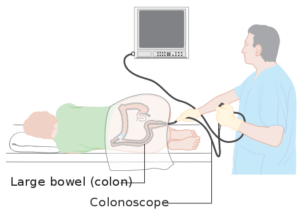Have you seen both “colonoscopy” and “colposcopy” in the same information about one of these procedures?
If you’re confused, here’s the difference.
The situation can go both ways, as follows:
You’re reading information about a colonoscopy, and at some point, the word colposcopy comes up, but then the ensuing term continues to be colonoscopy.
Or, you’re reading about a colposcopy, and somewhere in there, the procedure is suddenly called a colonoscopy.
You’ve discovered this switching of words in any of the following media:
- A blog
- A response in an online community forum
- An article on a health site
- An email to you from a layperson or doctor
I’ve seen the switch at least twice now, and one of the switches appeared in content written by a physician.
This can be quite confusing to laypeople, as they’ll then wonder if colposcopy is another name for a colonoscopy or vice versa.
However, there’s a huge difference between these two procedures!
The reason for the switching is that of simple keystroke error.
Fast-typing fingers spell out unintended words – that sound like the intended words – all the time.
Even when someone proofreads their content, eyes that are moving too quickly can miss the unintended word.
What is a colonoscopy?
A colonoscopy is an imaging procedure conducted by a gastroenterologist to view the interior of the patient’s large colon.
“The colonoscope is a flexible narrow tube which is about four feet long,” says Dr. David Beatty, MD, a retired general practitioner with 30+ years of experience and an instructor of general medicine for 20+ years.
“The scope is passed into the anus, through the rectum and into the colon,” continues Dr. Beatty.
“The inside of the colon can be photographed or biopsies can be taken — when a sample of the bowel wall is taken for analysis.

Colonoscopy. Cancer Research UK
“Polyps and even some tumors can be removed through the scope. Bleeding points may be cauterized.”
A colonoscopy is a routine screening procedure that’s recommended for the general population beginning at age 45 to detect any precancerous polyps in the colon.
Dr. Beatty cites the following symptoms that would warrant a diagnostic colonoscopy: rectal bleeding, abdominal pain or swelling, unexplained weight loss or fatigue, and new-onset diarrhea alternating with constipation.
What is a colposcopy?
At first glance, these words appear quite similar. And fast fingers may accidentally type out colposcopy when the intended word is colonoscopy.
It’s also possible that voice recognition software can confuse the two words.
A colposcopy is an imaging procedure performed by an OBGYN to view a woman’s vulva, vagina and cervix for any signs of disease.
The viewing instrument – which magnifies the patient’s interior – is called a colposcope.
It’s held a few inches from the vulva. With the aid of a bright light, the doctor looks through the lens.
The instrument kind of resembles oversized binoculars.

Colposcopy. Shutterstock/Fancy Studio
A colposcopy is not a screening procedure. It’s used when there’s a suspicion for precancerous lesions in the vulva, vagina or cervix, or to diagnose genital warts.
What leads up to the diagnostic colposcopy in the first place includes an abnormal or inconclusive Pap smear, and vaginal bleeding that was not explained by an initial investigation.
So next time you see colposcopy in content about a tube going through someone’s colon, or colonoscopy when the information is about viewing a woman’s reproductive anatomy, you’ll know it’s just a slip of the fingers or an error with voice recognition software.
 Dr. Beatty has worked in primary medicine, surgery, accident and emergency, OBGYN, pediatrics and chronic disease management. He is the Doctor of Medicine for Strong Home Gym.
Dr. Beatty has worked in primary medicine, surgery, accident and emergency, OBGYN, pediatrics and chronic disease management. He is the Doctor of Medicine for Strong Home Gym.
 Lorra Garrick has been covering medical, fitness and cybersecurity topics for many years, having written thousands of articles for print magazines and websites, including as a ghostwriter. She’s also a former ACE-certified personal trainer.
Lorra Garrick has been covering medical, fitness and cybersecurity topics for many years, having written thousands of articles for print magazines and websites, including as a ghostwriter. She’s also a former ACE-certified personal trainer.
.










































